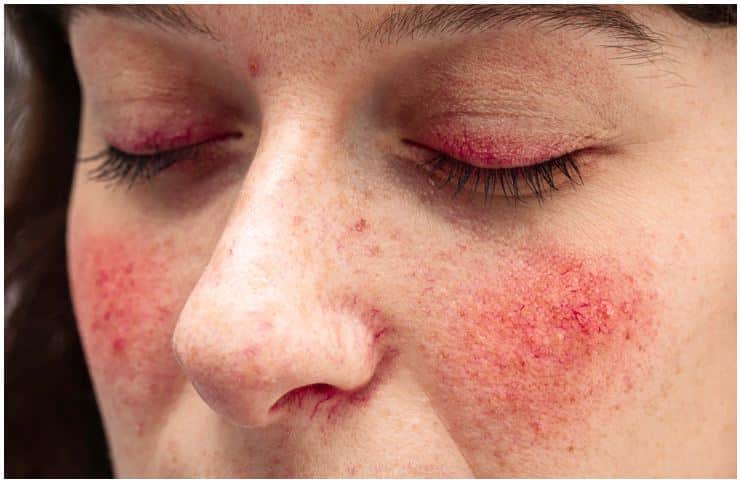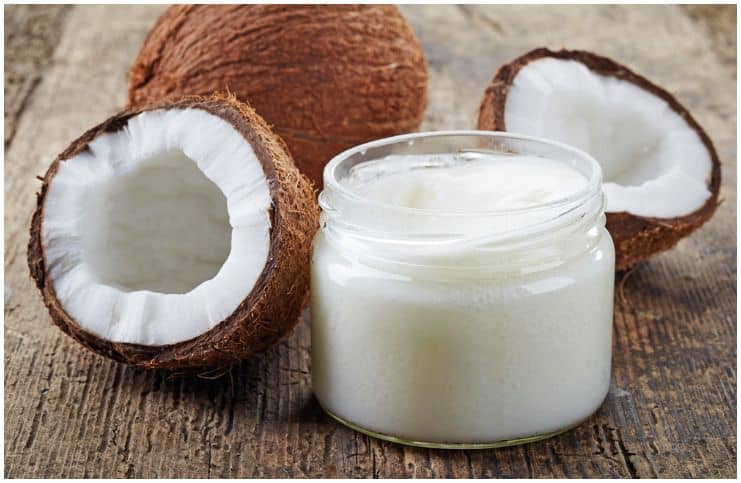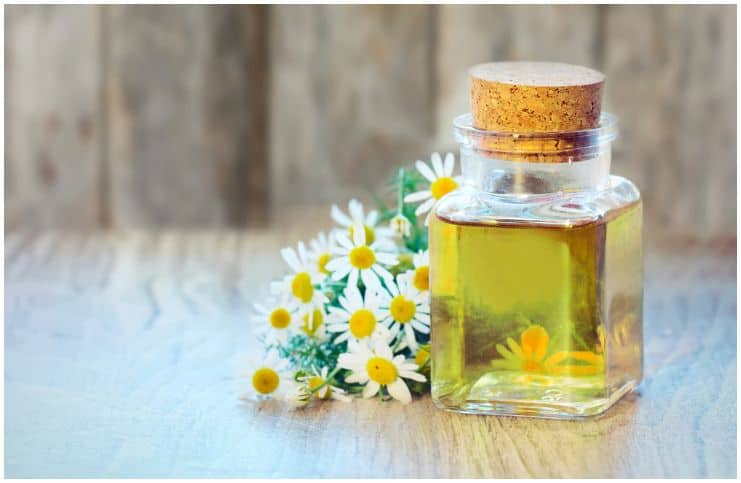There are a few skin conditions that can produce redness around the nose, mouth, cheeks, and chin. Bellow, you can find a list of symptoms and causes, as well as natural treatments.
Perioral dermatitis
Perioral dermatitis, also named periorificial dermatitis, is a condition characterized by tiny red bumps which form around the mouth, nose, and chin and even up near the eyes or on the neck.
The rash is not painful or itchy and can look similar to acne. However, it causes considerable physical, aesthetic, and psychological discomfort to a person.
Symptoms – visible blood vessels, skin thickening, bumps around the mouth that may be filled with pus or fluid.
Causes – cosmetics (facial creams with steroids), toothpaste additives, make-up, or neglecting to wash the face.
Tip – if you are using topical corticosteroids, it is recommended to stop using entirely, if possible.
Rosacea
This is a long-term incurable skin condition, adult acne-like, distinguished by facial redness, small bumps, and superficial dilated blood vessels on the facial skin.
It usually affects the nose and has periodic flares and remissions. This skin condition affects around 16 million people in the United States. Worldwide, over 5 percent of the adult population is affected by this skin condition.
Rosacea is more common in females but when affecting males, the skin condition may be more severe.
Symptoms – the general age when these symptoms occur is in your 30s-60s and include – facial (cheeks, chin, nose, or forehead) redness and flushing, visible blood vessels, spots, pustules and papules, dry eyes, and thickened skin.
Causes – the exact cause of this disease is not known but sun damage, genes, alcohol, dairy products, hot or spicy foods, emotional stress, and heat may trigger it.
Tip – keeping track of your activities and symptoms in a journal may help you identify the specific triggers.
Seborrheic Dermatitis
Seborrheic dermatitis, also named seborrhea, is a chronic form of eczema that is slightly more frequent in men than in women.
In addition, infantile seborrhea affects babies under the age of 3 months but disappears by 6–12 months of age.
When an adult gets seborrhea, it can come and go for the rest of the person’s life.
Seborrheic dermatitis affects about 6 million adults and children in the United States.
Symptoms – red skin, yellowish or white crusty flakes, greasy and swollen appearance.
Causes – the precise cause of seborrhea is not completely understood, although genes, hormonal changes, stress, or depression can play an important role.
Tip – the severity of seborrhea can be lessened by paying careful attention to skincare and controlling risk factors.
Psoriasis
Psoriasis is a chronic autoimmune condition that is characterized by skin cells that multiply up to ten times faster than normal. It affects about 7.5 million women and men in the U.S.
Symptoms – stiff and swollen joints, red patches of skin covered with silvery scales, dry skin that may bleed and crack.
Psoriasis on the face will most frequently affect the following areas:
- upper forehead;
- the skin between the nose and upper lip;
- hairline;
- eyebrows.
Causes – usually autoimmune conditions are the result of the body attacking itself, more precisely the white blood cells attack the skin cells. Moreover, emotional stress, alcohol, dairy products, prescription medications are frequent triggers for psoriasis.
Tip – you can’t pass psoriasis from one person to another.
Natural Remedies For Redness Around The Nose And Mouth:
Cucumbers Mask
Cucumbers are mainly water but they also contain natural acids (ascorbic acid) that help to reduce swelling and soothe the skin. Cucumbers also contain silica, an essential mineral that replenishes the skin.
In addition, cucumbers are rich in vitamin E (a fat-soluble nutrient that is found in many foods), a powerful antioxidant that fights against the free radicals causing skin disorders. Lastly, cucumbers have the exact same ph as our skin.
Aloe Vera Gel
This plant has been used in herbal medicine for over 2,000 years for its antiseptic, antibacterial, and anti-inflammatory properties.
Furthermore, aloe vera protects the skin from pathogens that can produce inflammation and infection. Aloe contains minerals, vitamins, and essential amino acids that work wonders for the skin.
Essential Oils
Essential oils for acne, such as frankincense, lavender, myrrh, rose, tea tree have the capacity to fight sleep deprivation and insomnia, alleviate feelings of anxiety and stress, and balance hormone levels.
Additionally, they encourage new cell growth, thus, helping to reduce the appearance of scars and wrinkles.
Grape Seed Extract
Grape seeds are rich in potent antioxidants and natural plant substances named OPCs – oligomeric proanthocyanidin complexes.
More importantly, this extract is a highly concentrated source of linoleic acid, vitamin E, and tannins, which all mixed together promote healthy skin.
Colloidal Oatmeal
This remedy is actually oats that are finely milled and then suspended in gel or water. Oats are an important source of avenanthramide (Anthranilic acid amides), powerful antioxidant substances with anti-inflammatory properties.
Zinc Oxide
This remedy has been used for the treatment and health of the skin.
Zinc oxide works by providing a skin barrier that prevents and heals skin irritation by improving wound healing rate, lowering inflammation levels, and preventing bacterial infections.
Coconut Oil
it is able to penetrate your skin on a deeper level than your cream because of the way it bonds with proteins.
Applied to the skin, coconut oil has been established to help reduce the level of microbes, yeast, and fungus which all can lead to too much oiliness, irritation, or dryness.
Green Tea
This tea contains a storehouse of powerful antioxidants named catechins, which offer natural anti-inflammatory protection, to calm the puffiness and reduce the redness.
Furthermore, drinking green tea regularly prevents new acne breakouts, which are caused by bacteria, because the catechins in tea kill bad bacteria while maintaining good bacteria.
Chamomile Tea
This plant is a general name for a few daisy-like plants in the family Asteraceae. The name is said to mean “earth apple.”
Numerous active ingredients in chamomile have healing properties, including the flavonoids luteolin, apigenin, and quercetin, and the volatile oils (including bisabolol, matricin, and bisabolol oxides A and B) which all work in synergy to reduce congestion, pain, swelling, inflammation, and redness.
Horse Chestnut
It is a tree native to the Balkan Peninsula with a high level of saponins (more exactly aescin) that makes it an effective skin purifier.
Nutrition
It is recommended to avoid spicy and hot foods, hot drinks, alcohol, cigarettes, and dairy products.
Try consuming more anti-inflammatory foods like – watermelon, spinach, cucumber, kale, coconut, almonds, celery, broccoli, tomatoes, cherries, blueberries, strawberries, oranges. Also, you should consume plenty of water.
References http://www.nytimes.com/health/guides/disease/seborrheic-dermatitis/overview.html http://www.mayoclinic.org/diseases-conditions/rosacea/symptoms-causes/dxc-20235172 http://umm.edu/health/medical/altmed/herb/grape-seed http://www.webmd.com/drugs/2/drug-18449/colloidal-oatmeal-topical/details





